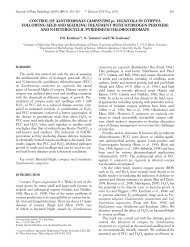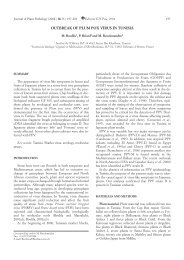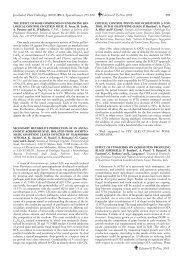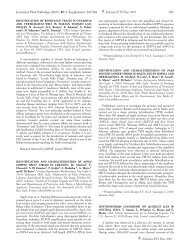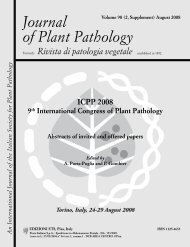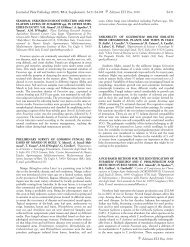Journal of Plant Pathology - Sipav.org
Journal of Plant Pathology - Sipav.org
Journal of Plant Pathology - Sipav.org
You also want an ePaper? Increase the reach of your titles
YUMPU automatically turns print PDFs into web optimized ePapers that Google loves.
S1.12 Fungicide sensitivity <strong>of</strong> Septoria tritici <strong>Journal</strong> <strong>of</strong> <strong>Plant</strong> <strong>Pathology</strong> (2011), 93 (1, Supplement), S1.7-S1.13<br />
2009). In contrast, triazole sensitivity <strong>of</strong> S. tritici fluctuated<br />
(Table 1, Fig. 3A), suggesting that the factors affecting<br />
sensitivity development over time were different<br />
between G. zeae and S. tritici. G. zeae causes a monocyclic<br />
disease that is targeted by one spray per season at<br />
maximum, whereas S. tritici elicits a polycyclic disease<br />
targeted by 1 to 3 sprays per season. Hence, effects <strong>of</strong><br />
fungicide regimes on sensitivity are likely to become obvious<br />
in a shorter period <strong>of</strong> time in S. tritici than in G.<br />
zeae. Furthermore, mycotoxin levels associated with<br />
Fusarium head blight pathogens were hardly reduced<br />
by QoIs (Chala et al., 2003), and, therefore, azoles were<br />
preferentially applied against Fusarium species, whereas<br />
QoIs were largely avoided, resulting in a moderate but<br />
permanent selective pressure <strong>of</strong> DMIs on G. zeae with<br />
hardly an interference by QoIs.<br />
Leroux et al. (2007) reported that some mutations in<br />
the CYP51 gene were associated with changes in sensitivity<br />
<strong>of</strong> European S. tritici strains towards DMIs. Data<br />
by Brunner et al. (2008) suggest that CYP51 mutations<br />
conferring partial resistance towards azoles probably<br />
arose in Denmark or UK and then spread towards eastern<br />
Europe. Furthermore, no CYP51 mutations conferring<br />
partial resistance towards azoles have been found<br />
in non-European populations so far (Brunner et al.,<br />
2008). Stammler et al. (2008) screened 615 strains sampled<br />
in 2007 throughout Europe for their sensitivity towards<br />
epoxiconazole. They found no consistent relationship<br />
between CYP51 haplotypes and sensitivity. In<br />
our study, less isolates from the same region were tested,<br />
but over a longer period <strong>of</strong> time, allowing us to study<br />
the effects <strong>of</strong> temporal factors on fungicide sensitivity,<br />
largely unbiased by spatial factors. A general interpretation<br />
<strong>of</strong> our results focusing on the effect <strong>of</strong> the composition<br />
<strong>of</strong> fungicide sprays on sensitivity over time is given<br />
below.<br />
General interpretation. Changes <strong>of</strong> fungicide sensitivity<br />
over time were characteristic and very consistent<br />
for each group <strong>of</strong> fungicides having the same mode <strong>of</strong><br />
action (Fig. 3). In 1999, DMIs were used on a routine<br />
basis against S. tritici in northern Germany (Fig. 3B). In<br />
subsequent years, QoIs use increased dramatically (Fig.<br />
3B), such that the selective pressure on S. tritici was not<br />
exerted by DMIs alone. Despite approximately constant<br />
use <strong>of</strong> DMIs at high frequency (Fig. 3B), EC 50<br />
values<br />
for DMIs slightly decreased during the period <strong>of</strong> frequent<br />
QoI use until 2004.<br />
First S. tritici isolates resistant towards strobilurins<br />
were found in UK in 2002 (Fraaije et al., 2005) resulting<br />
in a decrease <strong>of</strong> QoI use for S. tritici control in subsequent<br />
years. Hence, the fraction <strong>of</strong> selective pressure applied<br />
by DMIs increased again and is reflected by an increase<br />
<strong>of</strong> EC 50<br />
for azoles until 2008. Interestingly, prothioconazole<br />
followed the sensitivity pattern <strong>of</strong> azoles, even<br />
though it was not yet introduced to the market in 1999.<br />
Hence, at least a limited degree <strong>of</strong> cross resistance between<br />
(tri)azoles seems to exist in S. tritici. Given the<br />
continuous use <strong>of</strong> DMIs at high frequency and earlier reports<br />
on mutations <strong>of</strong> the DMI target gene CYP51 (Leroux<br />
et al., 2007), resistance phenomena observed in our<br />
study were surprisingly small, raising the question<br />
whether CYP51 is the only DMI target in S. tritici.<br />
Fungicides having a different mode <strong>of</strong> action such as<br />
folpet or chlorothalonil resulted in a different pattern <strong>of</strong><br />
sensitivity development over time. Generally, development<br />
<strong>of</strong> resistance towards multi site inhibitors is considered<br />
to be more unlikely than development towards single<br />
site inhibitors, because several toxic mechanisms have<br />
to be circumvented by the target <strong>org</strong>anism at the same<br />
time with multi site inhibitors, whereas only one mutation<br />
can confer resistance to single site inhibitors (Deising<br />
et al., 2008). Even though the changes in sensitivity<br />
were non-significant for the multi site inhibitors folpet<br />
and chlorothalonil in our study, the consistency <strong>of</strong> EC 50<br />
changes over time suggests that S. tritici populations have<br />
the potential to adapt also to multi site inhibitors on a<br />
long term perspective. Furthermore, EC 50<br />
s for multi site<br />
inhibitors slightly increased during the period <strong>of</strong> QoI use<br />
and decreased again afterwards. This phenomenon might<br />
be interpreted as evidence for a limited degree <strong>of</strong> cross<br />
resistance between trifloxystrobin and the multi site inhibitors,<br />
raising the question whether the multi site inhibitors<br />
used here may – at least partly – affect mitochondrial<br />
respiration, as trifloxystobin does.<br />
The low number <strong>of</strong> strains available for 2004 from<br />
the particular region <strong>of</strong> interest was rather unsatisfying.<br />
However, the main effect (interaction between time and<br />
fungicidal mode <strong>of</strong> action) <strong>of</strong> this paper did not depend<br />
on the data from 2004. In fact, the effect <strong>of</strong> time × fungicide<br />
on log(EC 50<br />
) (same analysis as given in Table 1)<br />
was significant at P



